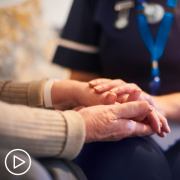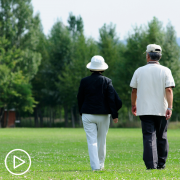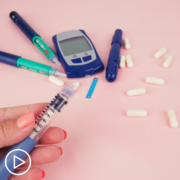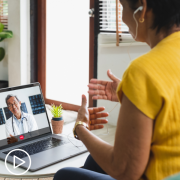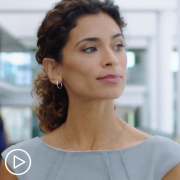Which MPN Treatment Is Right for You? What You Need to Know from Patient Empowerment Network on Vimeo.
What should you know before deciding which treatment is best for YOUR MPN? MPN expert Dr. John Mascarenhas reviews key factors–including essential testing–that guide treatment decisions for essential thrombocythemia (ET), polycythemia vera (PV), and myelofibrosis (MF). Dr. Mascarenhas also provides an overview of available treatment types and why he’s hopeful about the future of MPN research.
Dr. John Mascarenhas is Associate Professor of Medicine at the Icahn School of Medicine at Mount Sinai (ISMMS) and the Director of the Adult Leukemia Program and Leader of Clinical Investigation within the Myeloproliferative Disorders Program at Mount Sinai. Learn more about Dr. Mascarenhas, here.
See More from INSIST! MPNs
Download Guide
Related Programs
Transcript
Katherine:
Hello, and welcome. I’m Katherine Banwell, your host for today’s program. Today, we’re going to discuss how to access the most personalized therapy for your MPN and how you might benefit from key testing. Before we get into the discussion, please remember that this program is not a substitute for seeking medical advice. Please refer to your healthcare team about what might be best for you.
All right. Let’s meet our guest today. Joining me is Dr. Mascarenhas. Welcome. Would you please introduce yourself?
Dr. Mascarenhas:
Thanks for having me. My name is John Mascarenhas. I am an associate professor at the Icahn School of Medicine here at Mount Sinai in New York City, and I am a clinical investigator in myeloproliferative neoplasms, and I direct the Adult Leukemia Program here.
Katherine:
Excellent. Thank you so much for taking the time out of your busy schedule to join us today. Before we delve into our discussion, let’s start with a term we’ve been hearing a lot about recently. How would you define “personalized medicine?”
Dr. Mascarenhas:
So, it’s a good question because I think it’s poorly defined in many ways because it can mean different things I think to different people. And, it’s a definition that’s in evolution. So, I think at its core, personalized medicine tries to embody the concept of creating an evaluation and management plan that is specific of tailored to that patient on multiple levels.
On a personal level, on an objective level of what the patient’s objectives are with their therapy or their disease, and then on a biologic level in terms of the type of disease, and now increasingly, on a molecular level. So, in some cases, it may be personalized therapeutics that are specific or targeted to certain mutations that the patient may have. And, that’s kind of where things are evolving from a treatment perspective. And to me, personalized medicine should be the goal of any interaction with a patient that you have to personalize the approach. Because, every patient that we meet is quite different and distinct from the next patient, and their own sensitivities, understandings and desires can be quite different. So, you want to personalize that approach to that patient at the most basic level.
Katherine:
Yeah. Well, that’s really helpful as we move through today’s program, which is going to cover the three classic MPNs, polycythemia vera, essential thrombocythemia and myelofibrosis. So, for someone who has one of these conditions, can you help us understand how one may progress to the next?
Dr. Mascarenhas:
So, these are a very heterogeneous or variable group of diseases that are under an umbrella called the myeloproliferative neoplasm. So, MPNs can really present and behave and have very different clinical courses. So, I think it’s very important for patients to realize that these are rare diseases, that that has a complexity to it, because they don’t always have the ability or the privilege to know other patients or people in their lives that may have these diseases. So, it could be very frightening from a level of feeling isolated or alone with a diagnosis like this and not having familiarity, but also, that these are vague diagnoses in the sense that when you have breast cancer, one can kind of conceptualize that there is a mass in the breast, for example, and that that can be staged. It can go to the lymph nodes in the armpit, it could spread below. And people can kind of understand that concept. I think it’s a little bit more challenging when you talk about MPNs, because it’s a little bit more abstract.
These diseases are within the bone marrows at diagnosis. So, they’re not staged in a physical way, and they are complex because they can lead to high blood counts, low blood counts, different types of symptoms, and the approaches really have to be personalized. They are all three interrelated because there are commonalities. So, there are certain clinical commonalities and also biologic commonalities. So, for example, the JAK2 mutation, the JAK2V617F mutation is seen in all three diseases. So, it’s not specific to one or the other.
It’s more common in polycythemia vera, but in about 50 percent of patients with ET, and 50 percent of patients with MF, you can see this mutation. So, the mutation alone doesn’t really tell us what the disease is. It just tells us you have one of these diseases. And, there are other mutations. So, a bone marrow biopsy then becomes integral in helping subtype the patient and then create that treatment plan and that outlook that’s specific for that disease.
And as you mentioned, to make it even more complicated, these diseases can overlap not just biologically, but in a continuum. So, patients with ET or polycythemia vera can progress in some cases to myelofibrosis. And, all three diseases in a minority of patients can progress or evolve into acute myeloid leukemia, which is a more aggressive form of bone marrow cancer.
Katherine:
Well, let’s turn to testing. And, you did just mention this. You touched on it a moment ago. What tests are necessary to help understand a patient’s specific disease at diagnosis?
Dr. Mascarenhas:
Usually, the blood counts are the first opening door test that allows some understanding of, again, either an abnormal production of red blood cells, platelets or under production of these cells. And, that’s really where often the evaluation begins. And then, there are further blood tests that often are done.
And I would say almost indefinitely or almost definitely one should have a bone marrow biopsy that helps categorize the type of myeloproliferative neoplasm because there can be overlap in how the blood counts can look from one disease to the next and overlap in the mutations like the JAK2 mutation. So, sometimes, the blood counts and the molecular testing are not enough, and a bone marrow biopsy looking under the microscope at the different types of cells, the proportion of cells, whether there’s fibrosis where there’s others other types of cells that shouldn’t be there, and they’re looking at the chromosomes and the flow cytometry, these are associated tests. As well as almost probably anywhere anyone goes at this point, they’re going to get next-generation sequencing, which is looking at multiple genes and mutations, and that gives a more broader, deeper sense of the disease.
So, those really become the integral parts. In some cases, patients will end up getting imaging of their abdomen to see if they have an enlarged spleen or enlarged liver.
Although that’s not always necessary, that is often part of the workup. So, it’s bloodwork, it’s bone marrow biopsy, sometimes imaging is usually the cornerstone.
Katherine:
And, what is molecular or biomarker testing?
Dr. Mascarenhas:
So, molecular testing today really means – at one point, it really meant looking at PCR for specific gene mutations.
So, for example, we would look at the JAK2 and we would say, “In a given person, is this gene mutated?” We all have JAK2 gene, but in patients with these diseases, they’re more commonly mutated which means altered in the blood cells. And, it’s very important for a patient to understand not in every cell in their bodies, but in their blood cell compartment. And, that helps us understand and start characterizing their disease, and sometimes that mutation can be measured. It can be at a low level. It could be a high level. And, that’s all put together in trying to understand the molecular basis of these diseases.
Today, next-generation sequencing has really taken over and that’s looking at more than just one gene.
Its sequencing could be 40 genes, it could be 200 genes, to get a sense of the complexity of the disease and looking for certain mutations which are considered biomarkers that can portend prognosis or I think increasingly, we’ll see may inform treatment decisions and may even be targets themselves of therapies.
Katherine:
Right. Should all patients diagnosed with ET, PV, or MF undergo biomarker testing? Is that necessary?
Dr. Mascarenhas:
I would say it’s part of the modern evaluation and management of patients today. I don’t think that that was true 10 years ago. But I think the field has matured. I will say I’m the first person to acknowledge to patients that we get a lot of information back, and the truth is we don’t often know what to do with all of that information. So, sometimes we get information back that can cause anxiety because you can see mutations in genes. But they don’t always inform us on how to educate the patient about their disease or tell us what to do with the treatment.
So, there is still a lag as there normally would be between the testing of the results that we get, and then the actual knowledge of what to do with that. And, that’s still a process that’s in evolution.
Katherine:
Right. Some patients may not know if they’ve received these important tests. So, what key questions should they ask their physician about testing?
Dr. Mascarenhas:
Well, I think it’s important that the patients feel empowered to understand sort of where the field is and what key questions you would ask a physician, hematologist who’s taking care of you. So, I think all patients should be aware of their diagnosis, the name of the diagnosis, the subtype, but also do they have any of the key driving mutations, the JAK2 mutation, the calreticulin mutation, the MPL mutation, and that’s usually done off of a bone marrow biopsy sample, but it can be done off peripheral blood. And, they may not always know that it’s done. So, I think having a discussion with the position to understand there are criteria that exist called the World Health Organization criteria that are updated frequently and should set a standard throughout the world of how you diagnose and establish these diagnoses.
So, I think it’s important for physicians to be able to convey to the patients with confidence, “We follow these criteria and you have these criteria and we’ve done this testing that shows that you have these mutations.” And not just regurgitate what they found, but help them understand and navigate with that means, which again, I will point out that sometimes we don’t know. But I think it’s important for physicians to convey sometimes that some of the findings that they may see, for example, patients look on portals these days and they can look at their labs and stuff like that. And, we don’t always have a terrific answer or an informed answer for everything that we get back. And, we will potentially in 10 years from now, but sometimes at the moment, we don’t. But I think a discussion about the meaning of the labs that are obtained is probably good for the patient to understand what’s being done.
Katherine:
Absolutely. It sounds like each person’s situation is unique and should be considered before making any treatment choices. Can you talk about how the results of these tests may affect prognosis and treatment?
Dr. Mascarenhas:
So, we do have risk stratification systems that we use for essential thrombocythemia, polycythemia vera, and myelofibrosis. I’ll talk about myelofibrosis because that’s probably a little bit more of a complex and sophisticated model. It’s also changing, and we update it frequently. And, these models are imperfect, so I always warn patients to not put all of their money in one basket when we talk about risk stratification. They broadly help us understand where a patient is in their disease course. So, for example, in myelofibrosis, historically, the DIPSS, the Dynamic International Prognostic Scoring System is used, which considered five clinical variables that have been shown to be independently prognostic. So, at age over 65, the presence of blasts or circulating immature cells in the peripheral blood, anemia, hemoglobin less than 10, symptoms, fevers, night sweats, weight loss or a high white count over 25,000, you those points up.
And patients can do this online. There are calculators that you can calculate your DIPSS score. And, you’ll see that there are four different risk groups that range from low risk to high risk, and they are associated with median survivals. We now know that mutations influence those, have influence on prognosis. So, there are a group of high molecular risk mutations like ASXL1, SRSF2, IDH1/2. So, there are mutations that also have prognostic significance, and we incorporate them into the decision-making.
And, essentially, and this is where I think patients have to be very careful, physicians have to be very careful with conveying this. With these risk models whether they are clinical variable risk models or these integrated molecular risk models, each category is associated with a median survival, that’s based on retrospective studies. But that doesn’t tell the patient specifically what they should expect in terms of survival. And, I always fear that patients, when they look at these things, or even physicians when they convey them that they may inadvertently misrepresent or convey what those really mean.
And, I think the purpose of those risk stratifications is really to help guide a risk adapted treatment approach that’s reasonable and is weighted for benefit to risk of the disease. So, for example, if you have advanced disease with a high-risk score of intermediate to or higher, bone marrow transplant in certain patients may be a warranted therapy to consider. So, they really help inform treatment.
Katherine:
Right. You mentioned a couple of these already. But, outside of testing, what other factors should be considered when choosing treatment?
Dr. Mascarenhas:
I think patient expectation. So, sometimes physicians and family will impose what they want for a patient, and that may not be what the patient really wants. So, I have learned over the years that it’s crucial to make sure that you understand the patient and what the patient’s expectations, desires, and that’s influenced by the life they’ve lead or the remaining life that they want to live and their own personal religious and spiritual beliefs.
] So, I think knowing your patient and understanding what their expectations are, it’s fundamental, and sometimes, it’s overlooked. So, understanding that, I think, is very crucial. And then, dividing what are the objectives of the treatment in a given patient? Is it really to improve anemia in some patient versus perhaps a different patient, it may be to improve their quality of life and reduce their symptom burden. And then in other patients, it may be purely trying to cure the disease with therapies that may be aggressive, which may not be appropriate for an older patient where toxicity could outweigh any potential benefit of survival or longevity. So, you really have to have a discussion with the patient or caregivers, and then define what are the goals in that individual to personalize that approach for that patient.
Katherine:
Right. Right. And, there’s the patient’s overall health, comorbidities, other things like that?
Dr. Mascarenhas:
Yeah, because we are not treating a disease in isolation usually. So, patients come with baggage posed of past diseases, current diseases.
And sometimes patients are not “fit” for certain types of therapies because they may be sick or they may have organ dysfunction that would make certain types of treatment approaches ill-advised because the toxicity could be higher. So, absolutely, you need to know their comorbid index, how much comorbidities they have and also their performance status, how active and how well they are in general.
Katherine:
Right. Are there specific biomarkers that may affect prognosis or treatment?
Dr. Mascarenhas:
So, yes and no. I mean, I think that’s an area of intense interest and research. So, we have identified certain biomarkers that have, as I mentioned, prognostic significance, and that may influence treatment decisions. So, patients who have, for example, as we discussed next-generation sequencing and we see their mutations that are present, if they have an accumulation of high molecular risk mutations, that may give us a sense that perhaps that patient may not enjoy the full benefit and duration of benefit of, for example, a JAK inhibitor as another patient that has a less complex disease.
And, that doesn’t necessarily mean that the therapy is not appropriate for the patient. But it may help us plan and be prepared to move on to the next therapy sooner or to be more vigilant for changes that would tell us it’s time to move on. So, I think they help us maybe get a general sense of things and put things into perspective. They don’t always necessarily inform us on a change in therapy immediately or the next or the most immediate therapy. But I do think that that will change because I would predict in the next five to 10 years, I think that the number of available drugs for myelofibrosis, for example, will likely double from what it is now. I think we will have an armamentarium to choose from, and what we will learn from trials that are ongoing is there may be certain profiles, mutations, chromosomal profiles, other clinical variable profiles that we will learn from these trials that will help us to find upfront, “Well, this profile really should go with his medication. That profile should go with that medication.”
An early of example that would be we’re learning that not all patients with the JAK2 mutation are created equal, that you can have different burdens of JAK2 mutation. And, patients with low burden JAK2 mutation, for example, may fare better with up a specific JAK to inhibitor like pacritinib than patients who get treated with other JAK inhibitors like ruxolitinib.
So, there are differences even within patient defined by mutation that may help us predict which of the JAK inhibitors, as an example, may be more appropriate as a first-line therapy. So, I think that will evolve more so over the next five to 10 years.
Katherine:
Dr. Mascarenhas, what is inhibitor therapy and how does that work?
Dr. Mascarenhas:
So, inhibitor therapy in general are usually oral drugs for the most part, small molecule inhibitors that are geared and usually specific but not totally specific because then they can have off-target effects, but geared to inhibiting usually an enzyme that is overactive or is contributing to the pathophysiology of the disease.
I think in MF, probably one of the best examples is a JAK2 inhibitor. So, there are a number of JAK2 inhibitors that have been in clinical testing. There are two that are approved, ruxolitinib (Jakafi) and fedratinib (Inrebic), which are excellent drugs in inhibiting JAK2 protein itself in the cells that could be either upregulated or hyperactive in the signaling pathway, and it quiets down a signaling pathway in the hematopoietic cells that leads to a lot of the manifestations of the disease, namely symptoms and spleen.
So, one of the clear benefits of JAK inhibitors that was established many years ago and reinforced by multiple drugs that are either approved or in late-stage testing is these drugs are excellent in improving the symptom burden in the patients and reducing their spleen. Unfortunately, as a class, we’ve not seen these drugs induce remissions or cure patients. So, there’s still interest in developing, obviously, non-JAK inhibitor therapies. But inhibitors in general are inhibiting proteins that are either inappropriately activated or part of a cascade of signaling molecules that are contributing to the disease.
And they are not chemotherapeutic, which might be an important point to make. In past days, we’ve relied heavily in hematologic malignancies in using chemotherapies which are nonspecific and just kill dividing cells whereas inhibitors typically are targeted, and in some sense, it’s personalized to the disease with toxicity profiles that are usually quite distinct from the traditional chemotherapies that we use.
Katherine:
Well, outside of inhibitor therapy, let’s review other treatments for patients. Depending on the patient, it seems like ET or PV may be easily managed. So, how are they treated? Let’s start with essential thrombocythemia or ET.
Dr. Mascarenhas:
So, ET is a disease in which first and foremost, we’re trying to reduce the risk of thrombosis, clotting, and/or hemorrhage bleeding. So, typically, ET patients are risk stratified by low risk or high risk.
It’s almost simply based on their age, whether they’ve had a clot in the past, and some systems now even incorporate other factors like mutation status. And, you tailor the treatment based on their risk score. So, low risk ET patients don’t necessarily need to be treated. They can be followed expectantly and watched. The height of the platelet count does not predict thrombotic risk. So, we don’t treat the platelet count per se. A high-risk patient is at high risk for clotting. So, these patients almost invariably are getting aspirin at a baseline, and they are often on cytoreductive therapy. And sometimes, that is chemotherapy like hydroxyurea (Hydrea). Sometimes it’s a non-chemotherapeutic option and like anagrelide, and sometimes it’s a biologic therapy like interferon alfa either 2a, PEGASYS, or 2b ropeginterferon. And, these are therapies that have rationale, that have clinical data, that have demonstrated reduction in risk of clotting, which again is the reason why we treat high-risk ET patients.
Katherine:
And, what about PV, polycythemia vera?
Dr. Mascarenhas:
So, in polycythemia vera, it’s similar to ET. We risk stratify patients low and high risk based on age and clotting histories. And whether you’re low or high risk, we give PV patients aspirin or at least once daily, and we look to keep their hematocrit below a threshold of 45 percent. And sometimes in women, we even go lower, to 42 percent. But the idea is that controlling the hematocrit, which is one of the red blood cells indices, you reduce the risk of having clots, and that’s been shown actually many years ago and reinforced in a very well-known study called the CYTO-PV study in Italy documented that if you keep the hematocrit less than 45 percent, so, stringent control versus allowing for less stringent control between 45 to 50, that you reduce by fourfold the number of cardiovascular events that can occur.
So, we know that controlling the hematocrit is important, and that can be done, again, with hydroxyurea, interferon, and ruxolitinib. The JAK2 inhibitor has also proved specifically for patients who had an intolerance or refractory hydroxyurea, but also importantly as a drug that can address, probably better than most drugs in this field, the symptom burden that could be problematic for some of those patients. But it’s really about controlling the hematocrit.
Katherine:
Yeah. Since myelofibrosis is a progressive condition, I imagine that makes it more difficult to manage. So, what else is available for patients with myelofibrosis?
Dr. Mascarenhas:
The first line of treatment is typically a JAK inhibitor, although I would say that there are a subset of patients – well, there are patients we sometimes meet that have very low risk disease. They don’t have those clinical variables we discussed before that could uptick their risk score, and some of those patients can be watched.
And interestingly, there are a subset of patients that can have an indolent or slow form of the disease where they don’t have aggressive changes in their disease, their blood counts, their symptoms, their spleen, and don’t need immediate treatment. Most patients would benefit from a JAK inhibitor, although there are a subset of patients where their issue is less simple in spleen burden and it’s more anemia.
So, we take those patients where anemia’s the focus, we look at their erythropoietin level, which is their endogenous hormone level that regulates red blood cell production. If it’s low, we give them a lab-based form of erythropoietin, something called PROCRIT or Aranesp. If it’s high, we will move on. We can use a drug called danazol, which is a synthetic male androgen which can improve hemoglobin levels in 20 to 40 percent of patients. Or, we can use a drug called lenalidomide, which is an immunomodulatory drug. And, more recently, there’s a drug in testing called to luspatercept, which is an active activin receptor ligand trap. So, there is a growing armamentarium of drugs that can be used to try to alleviate the anemia which is present and can be a significant issue in about a quarter of patients with myelofibrosis upfront at time of diagnosis or about 75 percent through the course of their disease. So, that’s an unmet need that still requires attention and may alter the treatment plan for a given patient.
Katherine:
What about stem cell transplants?
Dr. Mascarenhas:
So, we relegate stem cell plant transplants for those patients as mentioned before that are higher risk because we think that the potential benefit-to-risk ratio is in favor of transplant.
Transplant is really a modality that is the only modality that offers the potential for cure, but it’s also a modality that poses a significant risk of morbidity and mortality associated with it. So, it has to really be taken very seriously. It can’t be the kind of treatment you would think of as a last resort at the last minute. Once you see a transplanter, if they’re interested in that therapy and see it early on in the disease course, in my opinion, to start that dialog and then figure out when is the optimal time to employ a bone marrow transplant, which is not a surgical procedure. It’s often thought to be surgical. It’s not a transplant of an organ. It’s a transplant of hematopoietic cells. So, it’s really an infusion of stem cells that then end up in the person’s bone marrow, and they create a whole new hematopoietic system and immune system. And with that, you can have an immune system that then goes after the myelofibrosis stem cells.
That’s called graft-versus-leukemia effect. But with that included graft-versus-host disease, which is when the new graft, the new immune system doesn’t always recognize well the person’s own tissues, whether it’s the liver, or the lung, or the skin, and you can have immunologic reactions to that.
So, that’s a complex discussion. But, transplant, typically for patients less than 70 years of age who have high-risk myelofibrosis or even up to 75 if they have a good performance status and as we said don’t have a lot of comorbid issues with a goal of cure. So, if you have someone where their goal is to try to maximize their time out of the hospital and they’re not focused on longevity, they’re focused on quality of life, that may not be an appropriate patient for transplantation. So, I think a very upfront, honest and a transparent discussion with the patient about what to expect with transplant, what are the pros and cons, what are the risks involved, and importantly does it match up with their expectations or their desires.
Katherine:
Right.
We have a question from Mike that we received prior to the program. He wants to know, “What does it mean to have high-risk myelofibrosis?”
Dr. Mascarenhas:
So, high-risk can be defined different ways. For example, if you’re using the DIPSS score, it means that you have enough of those points to put you in a category that would suggest that your disease is more likely in a shorter time period to cause significant morbidity and mortality than someone who has low risk disease. So, it’s really, as we said before, we don’t stage myelofibrosis like stage I, II, III, and IV metastatic disease. But we risk stratify patients. We put them in these categories, and that helps to decide what treatments may be more appropriate. And as we were discussing, transplant is a therapy if you’re a high-risk patient and you’re inclined and you don’t have a lot of comorbidities, and you’re not very advanced in age. That may be a treatment that is appropriate for a high-risk patient, a high risk for having a bad outcome of the disease within a shorter period of time.
Katherine:
Right.
And we have another question from Craig that we received earlier. “I’m currently receiving regular phlebotomies for PV, but my doctor is considering switching me to inhibitor therapy. What can I expect and are there side effects that I should be concerned about?”
Dr. Mascarenhas:
So, for some patients, therapeutic phlebotomy is all that they need, and they do very well with it, and they don’t need to take a therapeutic like a JAK inhibitor or hydroxyurea, which is a non-specific treatment.
But some patients do. So, some patients where if their risk score is higher and their risk for thrombosis, that may be an appropriate indication. And some patients have a lot of symptoms with their PV. So, not all PV patients present and behave the same way. Some patients have a very low symptom burden. Some patients have a very significant symptom burden. Itching, for example can be a very annoying and very troublesome symptom for patients with PV.
And, if you don’t have PV or you don’t know someone with PV, you may not understand or realize the negative impact of having intractable itching, often associated with taking a shower or warm water.
And, that can really detract from quality of life and cause a lot of anxiety. So, that’s an example of where sometimes a JAK inhibitor like ruxolitinib can be really lifesaving in terms of restoring quality-of-life and functionality to a patient.
Usually, drugs like ruxolitinib are very well-tolerated too, which we’re fortunate about. There’s not a lot of toxicity associated with them. So, for example, nausea, vomiting, diarrhea, hair falling out with chemotherapeutics, you really don’t see with ruxolitinib or Jakafi. Easy bruising, headaches and some dizziness up front sometimes may be seen. They’re usually low-grade and they’re usually fleeting. And usually, the benefit, the feel-good aspect of it outweighs toxicity that can be seen with the drugs. They are immunomodulatory drugs. So, ruxolitinib or Jakafi may increase, to some small extent, but likely, real extent, infectious complications like shingles, urinary tract infections, upper respiratory infections. So, sometimes there is this increased risk. It’s often outweighed by the benefit of the drug.
But, there are risks that are associated, and of course the results are not guaranteed. So, I always warn patients, be careful when you look at the package inserts or talk to the physicians. Risks are risks. They’re not guaranteed. So, most patients don’t have these toxicities, but one is at risk for toxicity whenever they take any medication.
Katherine:
Yeah. Before we close, Dr. Mascarenhas, let’s talk about research. Are there new developments that you’re excited about?
Dr. Mascarenhas:
Absolutely. So, what I’m happily interested in and involved in is clinical investigation and moving the field forward, and there are many people out there that are similarly involved and they’re doing really excellent work. So, I am super jazzed and enthusiastic and optimistic, and it’s what gets me work every day and inspires me is all of the effort that is happening. And, it’s a continuum. So, it’s not just one person trying to try a different drug here and there. It’s really a bringing together of many different people because these are rare diseases.
Many different people from many different institutions that have different areas of expertise, but have a common goal of translating from laboratory informed data, so, not just taking a dart and throwing it at the dartboard and hoping it sticks. But actually taking data that we learned from the lab and leveraging that information to develop therapies that are informed, that are targeted, that are personalized and going through a process of evaluating them to get them into the clinic, with the goal of, and I would say ambitiously, our goal these days is moving beyond trying to make patients feel better, which is an important goal, but it’s really can we really target the disease in a more effective way to induce remissions, to, dare I say, cure patients. So, I think the ambitious goal of the clinical investigators and laboratory investigators that are active in MPN research today is really one looking for an understanding at the basis of the biology of the disease to develop curative therapies. And, I am optimistic that that will happen.
And, I don’t mean happen in a hundred years from now. I mean happen in our lifetime. So, that’s where we’re going. There’s a lot of very exciting drugs, oral and intravenous drugs and they target very different types of aspects of the disease, and I think patients and physicians will see that maybe those drugs are used best in combination. So, the idea of using one drug, waiting for it to fail and using another drug is really old news, and much of oncology is combination therapy. So, taking drugs that have different targets or mechanisms of action and non-overlapping toxicity to try to better target and delete what’s called the myelofibrosis stem cell that’s the basic issue here, which we don’t effectively delete other than transplant. So, our goal would be to put bone marrow transplanters out of business.
Katherine:
Well, that’s a great plan. I hope that that can happen one day. Thank you so much for joining us today, Dr. Mascarenhas. We appreciate you taking the time.
Dr. Mascarenhas:
My pleasure.
Katherine:
And thank you to all of our partners.
To learn more about MPNs and to access tools to help you become a proactive patient, visit powerfulpatients.org. I’m Katherine Banwell. Thanks for joining us today. Thank you so much.




